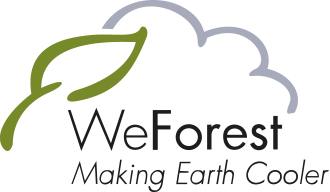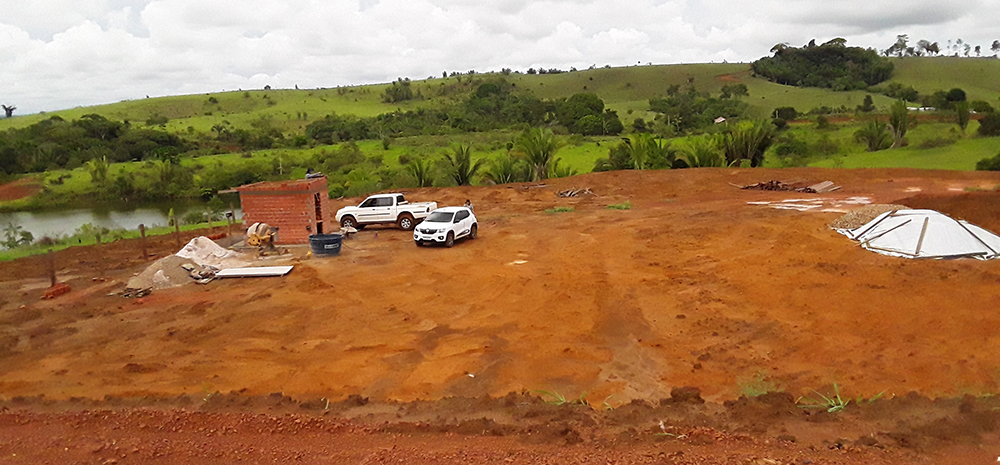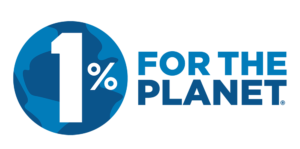
Our goal in Apuí, one of Amazonas State’s most deforested municipalities, is to restore 175 ha over five years.
To do this, we’ve partnered with IDESAM and scaled up their Apuí Coffee Agroforestry Systems initiative, in which farmers are supported to establish coffee agroforestry systems on their lands. Growing coffee in this way regenerates soil fertility, increases production and decreases the pressure on native forests, and with WeForest and IDESAM providing technical support and capacity building to participating farmers, the coffee’s market value increases.
The project is well on track, with another 35 ha of coffee agroforestry set to be established in the third planting season (2023-2024), which will bring the project to more than 100 ha in total over 37 farms. Some of our farmers who enrolled in the first year (the 2021-2022 planting season) have already enjoyed their first coffee yield; you can read about them in this report.
One of the project’s strengths is the expertise of IDESAM, who have been supporting farmers to take up coffee agroforestry here since 2012 and increasing their annual incomes by 220% in the process. With the planting in the 2023 cycle with WeForest and other partners, IDESAM’s activity here will reach a milestone of over 100 families benefiting from coffee agroforestry systems and more than 6000 hectares of forest conserved, not only in Apuí but also in the districts of Santo Antônio do Matupi and Sucunduri. It’s no wonder that for the fourth time, IDESAM has been named one of the 100 top Brazilian NGOs, and in 2023 bagged the top spot for NGOs focused on environmental issues! The year ended with the project featuring on TV – check it out here.
The planting of 46 200 coffee seedlings in the new agroforestry plots finished in January 2023, and the planting of 22 120 native tree and shrub seedlings was completed by March 2023. The average number of species planted per farm is 11 different species.
Scientific name | English name | IUCN Red List | Purpose |
|---|---|---|---|
Aspidosperma macrocarpon | – | Least concern | timber |
Carapa guianensis | crabwood | Least concern | crab oil (medicine)
|
Coffea canephora | robusta coffee | Least concern | cash crop: coffee |
Copaifera piresii | – | Least concern | traditional medicine |
Euterpe precatoria | açaí palm | Least concern | cash crop: acai berries |
Hymenaea courbaril | courbaril/West Indian locust | Least concern | traditional medicine; edible fruits |
Inga edulis | ice-cream bean | n/a | shade; edible fruits |
Swietenia macrophylla | mahogany | Vulnerable | timber |
Theobroma cacao | cacao tree | Least concern | cash crop: chocolate |
Schizolobium parahyba var. amazonicum | – | Least concern | – |
Gliricidia sepium (exotic) | quickstick | Least concern | |
Musa acuminata (exotic) | banana | Least concern |
Post-planting activities – removing invasive grasses and weeding – took place from March onwards. In 2023 WeForest supplied the farmers with tools and equipment for such maintenance activities thanks to funding from Delaware, and workshops were held from June onwards to train 45 farmers and their families in the best techniques to manage an agroforestry system. These included 23 families that have been in IDESAM’s Café Apui project for more than 6 years, well before WeForest came on board. Training should be constant in agroforestry projects, and IDESAM is carrying it out consistently, providing fine-tuning and adjustments according to performance. IDESAM has also produced a guide, “Management and Best Practices for Agroforestry Coffee Production”, available (in Portuguese) here.
During 2023 IDESAM procured some new equipment such as a machine that separates coffee beans, and sessions covering coffee processing steps such as harvesting, processing, roasting and grinding were also provided to Amazônia Agroflorestal, the spin-off from IDESAM which sells the products developed and guarantees market access.
WeForest’s Brazil Manager Natalia Guerin visited the project in November, and reports that it was interesting to see the development of the trees and the different approaches taken by the farmers in managing them. The IDESAM team usually recommends pruning the coffee at three months, so that it can develop new branches. Some farmers didn’t do this, and their coffee bushes are taller. Some farmers allowed natural regeneration – which happens really fast in this climate! – to occur on their agroforestry plots, such as Mr. Viriato who allowed Trema micrantha to flourish on his plot, providing shade for his coffee. In Mr. Ronivaldo’s plot, the inga trees also developed a lot and provided a lot of shade. In all these situations, the taller and shaded coffee trees didn’t suffer as much from the bad drought in September and October.
Mr. Ronivaldo’s agroforestry system planted in 2021. The inga trees are the tallest ones in the back. This site was previously used for conventional coffee production and has better soil conditions that allowed for the better development of the trees.
In plots such as those of Mr. Elpidio, Mr. Paulo and Mr. Jocimar, in which the coffee agroforestry is more open, the coffee felt more effects of the drought and was a bit yellow. This also varied according to the soil conditions of each farm.
Mr. Elpídio by his coffee trees planted in 2021, from which he already harvested 29 kg of coffee in 2023.
2023 also saw the implementation of the project’s monitoring and evaluation protocol, with a workshop between IDESAM and WeForest to develop the logframe taking place in February 2023. The logframe elaborates the objectives, indicators and means of verification.
One of the main challenges of the project is finding suppliers for materials, seedlings and service providers. Apuí is a region with a significant shortage of qualified labour, leading to a limited availability of good service providers such as tractor operators and logistics companies. This year, for example, the freight cost for limestone was about 25% higher than the amount paid for the purchase of 150 tons of limestone. In order to mitigate this, at least in terms of the seedlings, IDESAM started to set up its own tree nursery during 2023 (see box below).

Since the beginning of the project, the seedlings have been acquired in Porto Velho in the State of Rondônia, which is 600 km away. This can affect the quality and limit the diversity of planted species. To meet the challenge, IDESAM has raised funds to build a seedling nursery. A forest engineer is providing technical assistance, and the greenhouse, a shed and bathrooms will be finished during 2024 so that seedling production can begin. The nursery will have the capacity for 170,000 seedlings per year, starting with the coffee to ensure the quantity and quality of these seedlings, and then going on to also produce the native species. The nursery is an important step to upscale the project and decrease logistics costs.
IDESAM’s website features several interesting articles about our support for Apuí farmers and how it leads to income generation and improvement of quality of life, for example:
“Technical advice strengthens family farming in Apuí and production doubles in communities”
“Agroforestry systems in the Amazon as a tool for regenerative agriculture and climate mitigation”
This video (in Portuguese) was produced by Café Apuí Agroflorestal.
In November 2023 the soil was prepared for coffee planting across all the 15 engaged farmers’ plots. Usually planting starts then too, but this time there was a brief delay owing to the exceptional drought in Amazonas State, the worst in 121 years, with the Rio Negro river in Manaus seeing its lowest water level since 1902.
On September 28th 2023, the government of the state of Amazonas declared a state of emergency due to the severe drought affecting the state. Out of the 62 municipalities, 59 were already in a critical state of emergency. Many communities faced isolation and difficulty accessing clean water due to the low navigability of rivers, with over 633,000 people affected. The situation, exacerbated by the effects of El Niño, is a result of rampant deforestation that contributes to the worsening and prolongation of the drought. This, in turn, leads to an increase in wildfires, further exacerbating the effects of the dry spell and impacting rainfall patterns.
In addition to the drought, the high number of wildfires in the state is also a cause for concern. Between January and October of this year, 17,691 hotspots were recorded in the Amazonas region. According to the National Institute for Space Research (INPE), October alone saw 3,060 hotspots, more than double the number reported during the same period last year, which was 1,200. According to the data, the municipality of Apuí is the third most affected by wildfires in the state. Thankfully, none of the areas where WeForest and IDESAM work have been affected by the fires.
To help the affected communities, IDESAM reactivated the social campaign “Regatão do Bem“, which was created during the COVID-19 pandemic. Donations were converted into food, clean water, medications, and personal hygiene kits for communities in six locations. More information here.
Planting was finally able to start in January 2024 and is still ongoing at the time of writing. The average agroforestry tree density per hectare across all farms is 1952 seedlings per hectare: 1320 coffee and 632 native species (144 banana seedlings provided by the farmers themselves and 488 of the other species), so a total of about 68 320 seedlings will be planted on these new agroforestry plots.
Who grows the best coffee?
In 2023 IDESAM promoted the second contest for coffee quality amongst the farmers of the project (the ones who have been participating since before WeForest joined. Next year our WeForest farmers will be in the running too!). To participate in the championship, the farmers submit samples of their coffee to professional tasters who carry out the tasting and evaluation without knowing the producers’ identities. The top three producers with the best evaluations were awarded cash prizes provided by Amazônia Agroflorestal during the main regional event, the Rodeo and Rural Producer Fair of Apuí in September. The first place winner was Mr. Viriato with a score of 88 points, considered worthy of a specialty coffee standard for export. His skills in selective harvesting and drying of the beans are key to good coffee production.
On May 24th, the first workshop organized by WeForest to connect our different projects in Brazil and Argentina was held. The discussion, involving representatives from WeForest, FVS (our partner in the Misiones project in Argentina) and IDESAM compared the coffee agroforestry here in Apuí with the yerba mate agroforestry we’re establishing in Misiones.
Both projects are at the early stages and share many similarities in terms of landscape, farmers’ profiles, and the use of well-known and widely consumed species (coffee and yerba mate) as drivers for the transformation of traditional systems that entail deforestation followed by agriculture or livestock production. They also share the same challenges: working with several farmers makes the standardization of production more difficult, and coffee and yerba mate are susceptible to market fluctuation.
Agroforestry combines agriculture and forestry; environmentally and socially-appropriate trees and shrubs are grown around or among crops or pastureland. It plays a critical role in successful landscape and forest restoration by:
IDESAM’s work in Apuí started in 2012, with each producer receiving support to recover 1 hectare of coffee plantation in an agroforestry system, with native trees for shade including jatoba and mahogany, as well as species whose fruits and seeds could be collected and sold, such as cocoa, açaí, Brazil nut, crabwood and copaiba. Regenerating coffee systems has doubled productivity in the region and enabled farmers to earn income from coffee and look to the future of essential oil production from native trees. Creating value in standing productive forests can prevent their degradation and destruction.
Please visit our What We Do web page for more information.
HQ (BE): WeForest asbl/vzw
Cantersteen 47, 1000 Brussels, Belgium
VAT number BE0826.151.968
Incorporated May 26th 2010
WeForest is a supporting member of:





| Cookie | Duration | Description |
|---|---|---|
| __cf_bm | 1 hour | This cookie, set by Cloudflare, is used to support Cloudflare Bot Management. |
| _GRECAPTCHA | 6 months | Google Recaptcha service sets this cookie to identify bots to protect the website against malicious spam attacks. |
| cookielawinfo-checbox-analytics | 11 months | This cookie is set by GDPR Cookie Consent plugin. The cookie is used to store the user consent for the cookies in the category "Analytics". |
| cookielawinfo-checbox-functional | 11 months | The cookie is set by GDPR cookie consent to record the user consent for the cookies in the category "Functional". |
| cookielawinfo-checbox-others | 11 months | This cookie is set by GDPR Cookie Consent plugin. The cookie is used to store the user consent for the cookies in the category "Other. |
| cookielawinfo-checkbox-advertisement | 1 year | Set by the GDPR Cookie Consent plugin, this cookie records the user consent for the cookies in the "Advertisement" category. |
| cookielawinfo-checkbox-necessary | 11 months | This cookie is set by GDPR Cookie Consent plugin. The cookies is used to store the user consent for the cookies in the category "Necessary". |
| cookielawinfo-checkbox-performance | 11 months | This cookie is set by GDPR Cookie Consent plugin. The cookie is used to store the user consent for the cookies in the category "Performance". |
| CookieLawInfoConsent | 1 year | CookieYes sets this cookie to record the default button state of the corresponding category and the status of CCPA. It works only in coordination with the primary cookie. |
| elementor | never | The website's WordPress theme uses this cookie. It allows the website owner to implement or change the website's content in real-time. |
| JSESSIONID | session | New Relic uses this cookie to store a session identifier so that New Relic can monitor session counts for an application. |
| Path | session | Description is currently not available. |
| viewed_cookie_policy | 11 months | The cookie is set by the GDPR Cookie Consent plugin and is used to store whether or not user has consented to the use of cookies. It does not store any personal data. |
| Cookie | Duration | Description |
|---|---|---|
| _hjAbsoluteSessionInProgress | 1 hour | Hotjar sets this cookie to detect a user's first pageview session, which is a True/False flag set by the cookie. |
| _hjIncludedInSessionSample_2773626 | 1 hour | Description is currently not available. |
| aka_debug | session | Vimeo sets this cookie which is essential for the website to play video functionality. |
| authstrategy | session | Description is currently not available. |
| li_gc | 6 months | Linkedin set this cookie for storing visitor's consent regarding using cookies for non-essential purposes. |
| lidc | 1 day | LinkedIn sets the lidc cookie to facilitate data center selection. |
| pll_language | 1 year | Polylang sets this cookie to remember the language the user selects when returning to the website and get the language information when unavailable in another way. |
| UserMatchHistory | 1 month | LinkedIn sets this cookie for LinkedIn Ads ID syncing. |
| Cookie | Duration | Description |
|---|---|---|
| SRM_B | 1 year 24 days | Used by Microsoft Advertising as a unique ID for visitors. |
| Cookie | Duration | Description |
|---|---|---|
| _ga | 1 year 1 month 4 days | Google Analytics sets this cookie to calculate visitor, session and campaign data and track site usage for the site's analytics report. The cookie stores information anonymously and assigns a randomly generated number to recognise unique visitors. |
| _ga_* | 1 year 1 month 4 days | Google Analytics sets this cookie to store and count page views. |
| _gcl_au | 3 months | Google Tag Manager sets the cookie to experiment advertisement efficiency of websites using their services. |
| _hjFirstSeen | 1 hour | Hotjar sets this cookie to identify a new user’s first session. It stores the true/false value, indicating whether it was the first time Hotjar saw this user. |
| _hjSession_* | 1 hour | Hotjar sets this cookie to ensure data from subsequent visits to the same site is attributed to the same user ID, which persists in the Hotjar User ID, which is unique to that site. |
| _hjSessionUser_* | 1 year | Hotjar sets this cookie to ensure data from subsequent visits to the same site is attributed to the same user ID, which persists in the Hotjar User ID, which is unique to that site. |
| ajs_anonymous_id | 1 year | This cookie is set by Segment to count the number of people who visit a certain site by tracking if they have visited before. |
| ajs_group_id | 1 year | This cookie is set by Segment to track visitor usage and events within the website. |
| ajs_user_id | 1 year | This cookie is set by Segment to help track visitor usage, events, target marketing, and also measure application performance and stability. |
| AnalyticsSyncHistory | 1 month | Linkedin set this cookie to store information about the time a sync took place with the lms_analytics cookie. |
| CLID | 1 year | Microsoft Clarity set this cookie to store information about how visitors interact with the website. The cookie helps to provide an analysis report. The data collection includes the number of visitors, where they visit the website, and the pages visited. |
| CONSENT | 2 years | YouTube sets this cookie via embedded YouTube videos and registers anonymous statistical data. |
| MR | 7 days | This cookie, set by Bing, is used to collect user information for analytics purposes. |
| s_vi | 2 years | An Adobe Analytics cookie that uses a unique visitor ID time/date stamp to identify a unique vistor to the website. |
| SM | session | Microsoft Clarity cookie set this cookie for synchronizing the MUID across Microsoft domains. |
| VISITOR_PRIVACY_METADATA | 6 months | Description is currently not available. |
| vuid | 1 year 1 month 4 days | Vimeo installs this cookie to collect tracking information by setting a unique ID to embed videos on the website. |
| Cookie | Duration | Description |
|---|---|---|
| ANONCHK | 10 minutes | The ANONCHK cookie, set by Bing, is used to store a user's session ID and verify ads' clicks on the Bing search engine. The cookie helps in reporting and personalization as well. |
| bcookie | 1 year | LinkedIn sets this cookie from LinkedIn share buttons and ad tags to recognize browser IDs. |
| bscookie | 1 year | LinkedIn sets this cookie to store performed actions on the website. |
| IDE | 1 year 24 days 1 minute | Google DoubleClick IDE cookies store information about how the user uses the website to present them with relevant ads according to the user profile. |
| li_sugr | 3 months | LinkedIn sets this cookie to collect user behaviour data to optimise the website and make advertisements on the website more relevant. |
| muc_ads | 1 year 1 month 4 days | Twitter sets this cookie to collect user behaviour and interaction data to optimize the website. |
| MUID | 1 year 24 days | Bing sets this cookie to recognise unique web browsers visiting Microsoft sites. This cookie is used for advertising, site analytics, and other operations. |
| personalization_id | 1 year 1 month 4 days | Twitter sets this cookie to integrate and share features for social media and also store information about how the user uses the website, for tracking and targeting. |
| test_cookie | 15 minutes | doubleclick.net sets this cookie to determine if the user's browser supports cookies. |
| VISITOR_INFO1_LIVE | 6 months | YouTube sets this cookie to measure bandwidth, determining whether the user gets the new or old player interface. |
| YSC | session | Youtube sets this cookie to track the views of embedded videos on Youtube pages. |
| yt-remote-connected-devices | never | YouTube sets this cookie to store the user's video preferences using embedded YouTube videos. |
| yt-remote-device-id | never | YouTube sets this cookie to store the user's video preferences using embedded YouTube videos. |
| yt.innertube::nextId | never | YouTube sets this cookie to register a unique ID to store data on what videos from YouTube the user has seen. |
| yt.innertube::requests | never | YouTube sets this cookie to register a unique ID to store data on what videos from YouTube the user has seen. |
| Cookie | Duration | Description |
|---|---|---|
| __tld__ | session | Description is currently not available. |
| ajscookies | 1 year | No description available. |
| ajstest | 1 year | No description available. |
| debug | never | No description available. |